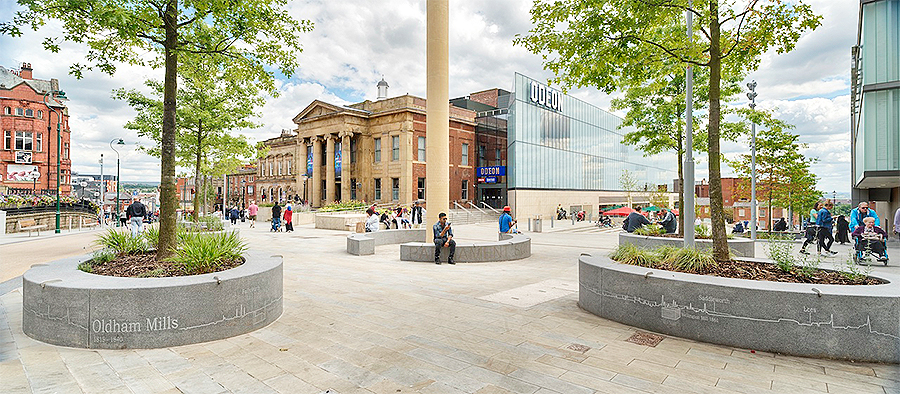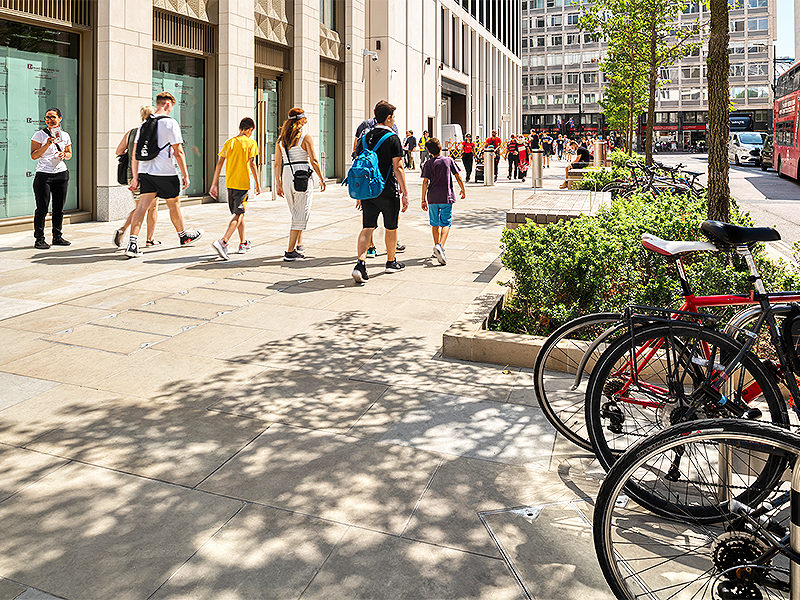Johanna Elvidge, Head of Design at building materials specialist Marshalls, reviews new research findings on the perceptions of public shared spaces and looks at how utilising design principles can help to increase the usage of these spaces and bring positive economic benefits.
Marshalls
Well-designed outdoor spaces are widely regarded for their health benefits, but the economic advantages and the impact they have on driving regeneration are also vital to their success.
Attractive public spaces can drive footfall to towns and cities bringing powerful benefits. As these spaces become a destination, it can lead to greater use of nearby services and businesses, enhance the desirability of an area and act as a catalyst for creating new jobs. More widely, increased footfall can also boost tourism and attract business investment.
However, to achieve these benefits, spaces need to be safe, feel welcoming and be somewhere that people feel confident visiting.
Safety in public spaces
At Marshalls, we carried out some primary research on this subject, exploring the current use of public spaces and understanding the behaviours and perceptions surrounding safety and vulnerability.
In the Creating Safer Spaces research, it was found that 77% of people think about their safety when out and about in public, at least some of the time. Additional findings showed 84% of women feel more unsafe when out alone compared with 44% of men, and gay men are twice as likely to have safety on their minds compared with heterosexual men. In addition, 43% of those with disabilities say they worry about their safety some or all of the time, compared to 27% overall.
Age also plays a critical role in feelings of personal safety, with young people considering their safety more regularly than older people; almost 70% of those under 21 consider safety all the time, compared to just 10% of those over 60.
The research also explored the impact of day versus night, finding that four out of five people feel more unsafe when it’s dark in public spaces and are 12 times more likely to avoid such areas than in daylight hours.
It also uncovered that parks and gardens were seen as the most unsafe, with 81% of respondents avoiding these spaces at night. Residential streets were considered the safest public space, yet nearly 24% of people still avoided this during the evening.
Around 30% of all participants cited feeling most unsafe on a night out. Other activities that raised safety concerns included waiting for public transport (22%), exercising outdoors (16%), walking the dog (12%) and commuting (10%).
Pillars for design
To address the research findings and support designers and planners in creating public spaces, Marshalls has produced the Creating Safer Spaces whitepaper. The paper outlines seven design pillars, which can help make public spaces safer and more widely used, both during the day and at night. The seven design pillars are: eyes on
the street, vision and wayfinding, acoustics, accessibility, familiarity, technology and maintenance.
Visibility was a key concern for nearly all surveyed, with a lack of visibility one of the main reasons people feel less safe after dusk. How much people can see will often impact how safe they feel and, therefore, how much a space is used. Repetition of a distinct type or style of lighting can create familiarity and aid wayfinding, helping people to feel safe. In addition, people also feel safer when they are more visible to others, the perceptions of ‘social survellience’ helping to reduce anti-social behaviour.
Acoustics and the importance of soundscape quality form part of regulations for buildings and are usually focused on interiors. However, with the exception of road traffic noise, acoustics is often overlooked outdoors and in the public realm. Yet, there are many things designers can do to reduce unwanted noise, while also ensuring a space is not unnervingly quiet. Get this acoustic balance right in outdoor spaces, and you can help reassure people, whether it’s light or dark.
Fuelling the night-time economy
By improving the safety of shared spaces after dark, those responsible for the public realm should see financial benefits too.
The night-time economy is estimated to bring in over £60bn to the UK economy each year – a figure expected to rise as urban areas focus more on 24/7 living. However, with many public spaces designed with primarily daytime usage in mind, the opportunity to realise this economic impact is limited, especially when we consider that almost a third of respondents feel most unsafe when on a night out.
Not designing for dark also impacts commuters in winter months, as well as workers who travel to their place of work in darkness all year around. Night working is at its highest according to the Trades Union Congress, with 3.25 million night workers in the UK – approximately 11.5% of all employees. Therefore, a failure to consider the design of spaces, including transport hubs for hours after dusk, is a failure to consider the needs of those making a significant contribution to the economy.
Making spaces feel safe in the dark needs to be a design consideration at the start of a project. The issue of public safety is a multifaceted one and, as such, requires an equally multidimensional, holistic solution that drives change in the initial design process, giving due consideration to the safety concerns of all user demographics. By considering the seven design principles and giving greater thought to designing for all times of day, those responsible for the public realm can create spaces that feel and are safer for users, and improve the economic bottom line too.










